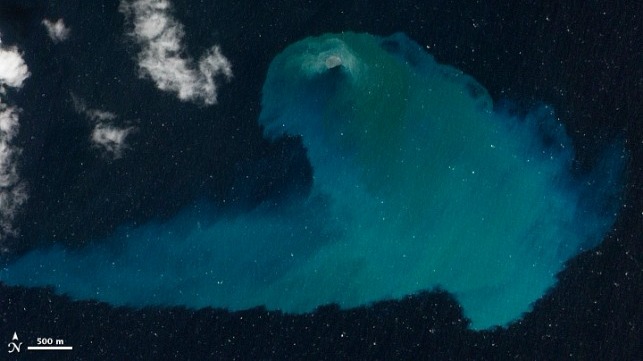Developing Prospects for Oceanic Geothermal Energy Conversion

While the earth’s core is believed to be molten material, the majority of the world’s active volcanoes are believed to be releasing vast amounts of thermal energy on the ocean floor. Accessing that thermal energy and producing electric power would require significant advances in existing deep-sea ocean thermal energy conversion (OTEC) technology.
Introduction
The combination of recreational and commercial diving revealed a difference in temperature between surface seawater and deeper seawater in tropical regions. While surface temperature of over 95 degrees F occurs at several tropical locations, water temperature declines with depth. That difference in temperature gave rise to research into ocean thermal energy conversion (OTEC) to generate electric power using organic Rankine-cycle engines. At depths of 3,300 feet, seawater temperature could be as low as 40 degrees F - unless there were active volcanoes releasing massive amounts of thermal energy from the seafloor, providing a new possibility for OTEC.
Existing OTEC technology relies on the small temperature differences between the surface and the ocean depths (TU Delft)
While undersea volcanic activity may begin at depths between several hundred to several thousand feet below sea level, the continuous release of molten magma results in the formation of undersea mountains. Over time, the ongoing release of sub-sea magma causes mountain peaks to protrude above the ocean surface to form islands such as Hawaii, Iceland and some Caribbean islands. Subterranean geothermal heat under Iceland allows that nation to generate 25 percent of its electricity from geothermal energy. There are deep-sea locations offshore from several countries where ongoing release of molten material significantly raises the temperature of deep seawater.
Heated Deep Seawater
While water boils at 212 degrees F at sea level atmospheric pressure, an increase in pressure raises the boiling point. A seawater depth of 5,000 ft yields a pressure of 2237 psia (160 bar) causing heated water to remain in the saturated state at 650 degrees F. Undersea volcanoes release molten material at between 1300 degrees F to 2280 degrees F, generating superheated steam that would rise upward until surrounding seawater sufficiently cools the steam for it to transform into saturated liquid. That heated seawater provides the basis of future ocean thermal energy conversion.
Offshore undersea volcanoes occur in locations near New Zealand’s north island, Iceland, Japan, southern Indonesia, Hawaii, eastern Taiwan, the Philippines and southern Italy. Over the past decade, the government of Iceland has actually considered developing an undersea electric power cable to connect to Ireland and the UK, with possible future extensions into Western Europe. The initiative was intended to attract investment into developing Iceland’s vast geothermal energy potential. Increased interest in expanding carbon-free electric power generation would likely prompt initiatives to access Iceland’s offshore high-temperature deep-seawater for the purpose of developing higher temperature ocean thermal energy conversion.
Modifying OTEC
The original OTEC technology involved a semi-submersible structure floating on the ocean surface of a tropical location connected via tension cables and insulated piping to the water intakes. Floating structures offer the advantage of being able to use tensile structural members to carry the weight of the piping. A series of buoys secured at regular intervals to each tension cable and each insulated pipe would reduce tensile stress along the pipe. Adapting the technology to gain access to deep-sea water heated by active seafloor volcanoes would likely involve extending the warm water intake pipe to extreme depth.
The nature of the temperature gradient between sea surface and seafloor would determine which depth of seawater would be used as the heat sink in a heat driven engine. An undersea volcano would likely release material that would remain dissolved in heated seawater until the temperature cools, causing the material to form mineral deposits in the inside of pipes. The use of an ultra-deep level heat exchanger perhaps made from stainless steel, would transfer heat from great depth to a closed-loop pipe system while preventing the formation of mineral deposits inside pipes as heat is carried to the surface.
Tension Cables
A semi-submersible offshore floating technology that access deep-sea thermal energy would need to be secured using undersea tension cables suspended by buoys, to a secure point beyond the volcanic seafloor region where the cables would need to be anchored so as to minimize horizontal movements of the assembly. Tension cables partially carried by buoys would extend to the deep-level heat exchanger. Heat released by an undersea volcano would cause heated water to rise upward as a plume or convection current and cooling as it rises. A heat exchanger could access heat at 210 degrees F to 570 degrees F.
The temperature that arrives at the engine in the floating assembly would determine whether a steam engine using distilled water or some form of organic Rankine-cycle engine would convert the incoming heat to electric power. Buoys would carry submerged and suspended electric power cables from the floating assembly to a region beyond the seafloor active volcanic area, from where the power cables would begin to rest on the seafloor as they extend toward land. The optimal offshore location for floating power station would be away from commercial shipping lanes.
Conclusions
OTEC technology installed at tropical locations such as offshore from India or Hawaii operates over a temperature difference of up to 60 degrees F between ocean surface and greater depth. Energy conversion efficiency is miniscule. Extensively modified OTEC technology that gains access to undersea volcanic heat can operate over a temperature difference of over 200 degrees F, using seawater temperature near the surface as the heat sink. The result is the combination of greater energy conversion efficiency and greater power output from a single installation, achieved after resolving the technical challenges of converting seafloor volcanic heat to electrical power.
The opinions expressed herein are the author's and not necessarily those of The Maritime Executive.
